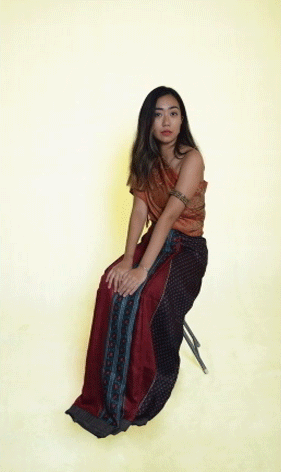



"Respect the culture and know the significance of what you're appropriating"
-Charissa Tung
A sari, saree, or shari is a female garment from the Indian subcontinent that consists of a drape varying from five to nine yards (4.5 metres to 8 metres) in length and two to four feet (60 cm to 1.20 m) in breadth that is typically wrapped around the waist, with one end draped over the shoulder, baring the midriff. There are various styles sari manufacture and draping, the most common being the Nivi style, which originated in Deccan region of India.
The sari is worn with fitted bodice commonly called a choli (ravike in South India, cholo in Nepal, choli elsewhere) and petticoat called parkar or pavadai.
Traditional Thai clothing is called chut thai, which literally means "Thai outfit". It can be worn by men, women, and children. Chut thai for women usually consists of a pha nung or a chong kraben, a blouse, and a sabai. Chut thai for men includes a chong kraben or pants, a Raj pattern shirt, with optional knee-length white socks and a sabai.



chut thai
Kuku Claudia
"Culture does not inherently belong to the people in that group "
-Tamara Elizabeth Mkeown
The baro’t saya is the national dress of the
Philippines. Barong being its masculine equivalent. Both are all traditionally made of piña though other materials that are not piña are also used in some baro't saya and barong.

Tamara Mckeown
baro't saya

The kimono is a traditional Japanese garment. The word "kimono", which actually means a "thing to wear" (ki "wear" and mono "thing"),has come to denote these full-length robes. The kimono is always worn for important festivals or formal occasions. It is a formal style of clothing associated with politeness and good manners.


The Cheongsam is a body-hugging one-piece Chinese dress for women, also known as qipao or qípáo, and was Republic of China's mandarin gown. The stylish and often tight-fitting cheongsam or qipao (chipao) that is best known today was created in the 1920s in Shanghai and made fashionable by socialites and upper class women.

cheongsam
Divya Suressh
"When done consensually and ethically, the appropriation of elements from other cultures allows for new strides in Fashion, Food and Music"
-Divyalakshmi Suressh


A kurta is an upper garment for men and women, originating in the Indian subcontinent, with regional variations of form.
The straight-cut kurta is a loose shirt falling either just above or somewhere below the knees of the wearer, and is traditionally worn by men. However, women do also wear the straight-cut kurta or its shorter version, the kurti. They were traditionally worn with loose-fitting paijama (kurta-paijama), loose-fitting shalwars, semi-tight (loose from the waist to the knees, and tight from the calves to the ankles) churidars, or wrapped-around dhotis

kurti patiala
Chaya Gonzales

The baju kurung is a traditional Malay costume which loosely translated as "enclosed dress". This type of costume is the national dress of Malaysia.
In Indonesia, it is one of the many regional dresses of this culturally and ethnically diverse country (especially on the island of Sumatra - where many ethnic Malay and Minangkabau women wear this). It can also be found in Singapore and Thailand.
baju kurung
Gouthami Rao

Thomas Brunning
kurta


A tangzhuang is a kind of pseudo-traditional Chinese jacket with a straight collar. It is an updated form of the Qing magua, itself a more fashionable adaptation of the riding jacket once worn by Manchu horsemen.
The tangzhuang is an adaption of the Manchu "horse jacket", a waist or three-quarter-length front-opening jacket or surcoat.] This was initially worn—usually in a dark blue color—by Manchu horsemen, but became mandatory for Han officials' clothing under the Qing Empire. Over time, it evolved from a protective apron for the changshan into an item of Chinese fashion in its own right.


Baju Melayu is a traditional Malay
outfit for men. It literally translates as 'Malay shirt' and consists of two main parts. The first being the baju (long sleeved shirt) The second part is the trousers called "seluar". A skirt-type adornment is worn with the Baju Melayu, which is the "kain samping".

baju melayu
Razeen Mujarrab

Dharshinee Elango
cheongsam
"When done consensually and ethically, the appropriation of elements from other"
-Dharshinee Elango

Lina Irdina
saree




Krisan Patricia
salwar kameez
Salwar kameez is the traditional Indian clothing for women. Due to its high popularity in the region of Punjab, shalwar kameez is commonly referred to as Punjabi suit.
Salwar, also pronounced shalwar, refers to the loose fit paijama that is quite wide at the top and in comparison pretty narrow at the bottom. The term Kameez on the other hand is used to refer to the long tunic.